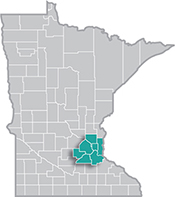 The Minneapolis-St. Paul metropolitan area is a national leader in finance, advanced manufacturing, agriculture and retailing.
The Minneapolis-St. Paul metropolitan area is a national leader in finance, advanced manufacturing, agriculture and retailing.
Medical devices, electronics and processed foods are strong suits recognized globally.
Want the freshest data delivered by email? Subscribe to our regional newsletters.
9/22/2022 9:00:00 AM
Tim O'Neill
October is Manufacturing Month in Minnesota. All month long, DEED will celebrate Manufacturing's vital place in the state's economy and labor force. Employers, career seekers, teachers, and students can learn all about the resources, data, and events for Manufacturing Month through CareerForce. These events include hiring events and job fairs for career seekers, career exploration for students, training grant overviews for businesses, and introductions to apprenticeships and youth skills training.
According to DEED's Occupational Employment & Wage Statistics (OEWS) data, the Twin Cities Metro Area has over 102,000 workers employed in production occupations. By Standard Occupational Classification (SOC), there are just over 100 unique production occupations. Some of the largest-employing production occupations in the Metro Area include First-Line Supervisors of Production & Operating Workers; Machinists; Inspectors, Testers, Sorters, Samplers & Weighers; Electrical, Electronic, and Electromechanical Assemblers; Welders, Cutters, Solderers, and Brazers; and Printing Press Operators.
To see which of these occupations are in demand in today's labor market, we can turn to DEED's Occupations in Demand (OID) tool. The OID tool combines local employment and job vacancy data to create a list of occupations from the most in-demand to the least in-demand. Table 1 highlights those top 15 production occupations in demand in the Metro Area, while also revealing the median annual wages, long-term employment projections, and typical education requirements for entry (Table 1).
| Table 1. Metro Area Production Occupations in Demand | ||||
|---|---|---|---|---|
| Job Title | Median Wage | 2020 – 2030 Projected Growth Rate | 2020 – 2030 Projected Openings* | Education Requirements |
| Miscellaneous Assemblers & Fabricators | $39,145 | -6.9% | +6,800 | High school diploma or equiv. |
| Machinists | $52,543 | +7.7% | +2,700 | Postsecondary vocational award |
| Packaging & Filling Machine Operators & Tenders | $39,474 | +6.3% | +1,800 | High school diploma or equiv. |
| Inspectors, Testers, Sorters, Samplers, & Weighers | $49,418 | -13.2% | +2,200 | High school diploma or equiv. |
| First-Line Supervisors of Production & Operating Workers | $66,223 | +3.5% | +2,100 | High school diploma or equiv. |
| Electrical, electronic, & electromechanical assemblers, except coil winders, tapers, & finishers | $39,281 | +3.0% | +2,400 | High school diploma or equiv. |
| Helpers--Production Workers | $30,922 | -2.2% | +1,300 | High school diploma or equiv. |
| Welders, Cutters, Solderers, & Brazers | $50,924 | +8.2% | +1,400 | High school diploma or equiv. |
| Computer Numerically Controlled Tool Operators | $50,643 | -2.2% | +800 | High school diploma or equiv. |
| Cutting, Punching, & Press Machine Setters, Operators, & Tenders, Metal & Plastic | $40,090 | -2.4% | +900 | High school diploma or equiv. |
| Coating, Painting, & Spraying Machine Setters, Operators, & Tenders | $48,739 | +5.6% | +700 | High school diploma or equiv. |
| Printing Press Operators | $44,460 | -10.0% | +1,300 | High school diploma or equiv. |
| Molding, Coremaking, & Casting Machine Setters, Operators, & Tenders, Metal & Plastic | $38,982 | -1.7% | +600 | High school diploma or equiv. |
| Bakers | $38,423 | +5.3% | +1,000 | High school diploma or equiv. |
| Food Batchmakers | $31,234 | +6.4% | +1,100 | High school diploma or equiv. |
| Source: DEED Occupations in Demand
*Includes net new openings and labor market exit openings |
||||
Of course, Manufacturing includes occupations beyond strictly production occupations. Using DEED's Staffing Patterns data along with OID, Table 2 reveals those top ten additional occupations with high demand in the Metro Area that have high employment concentrations within Manufacturing. Clearly, there is a lot of opportunity for those interested in Manufacturing in the Metro Area, whether that's with production-type occupations, transportation and material moving, engineering, sales and marketing, information technology, or other areas.
| Table 2. Metro Area Non-Production Occupations in Demand | ||||
|---|---|---|---|---|
| Job Title | Median Wage | 2020 – 2030 Projected Growth Rate | 2020 – 2030 Projected Openings* | Education Requirements |
| Customer Service Representatives | $48,147 | -3.9% | +19,500 | High school diploma or equiv. |
| Laborers & Freight, Stock & Material Movers, Hand | $39,624 | +7.4% | +13,200 | High school diploma or equiv. |
| Maintenance & Repair Workers, General | $49,734 | +4.1% | +5,100 | High school diploma or equiv. |
| Sales Representatives, Wholesale & Manufacturing | $66,903 | +2.5% | +7,300 | High school diploma or equiv. |
| General & Operations Managers | $102,302 | +7.1% | +7,800 | Bachelor's degree |
| Industrial Engineers | $103,541 | +11.6% | +2,600 | Bachelor's degree |
| Shipping, Receiving, & Inventory Clerks | $40,342 | -6.7% | +2,900 | High school diploma or equiv. |
| Industrial Production Managers | $121,962 | +4.6% | +800 | Bachelor's degree |
| Mechanical Engineers | $86,405 | +5.4% | +1,200 | Bachelor's degree |
| Industrial Machinery Mechanics | $64,678 | +19.5% | +2,100 | Postsecondary vocational award |
| Source: DEED Occupations in Demand
*Includes net new openings and labor market exit openings |
||||
Contact Tim O'Neill, Labor Market Analyst.